bio1134 ou ecology exam 3 questions and answers from mcgrawhill
1/67
There's no tags or description
Looks like no tags are added yet.
Name | Mastery | Learn | Test | Matching | Spaced |
|---|
No study sessions yet.
68 Terms
Members of a food web are equal in abundance and in their relative effects on one another.
false
Explanation - Species have different roles and impacts in a food web.
Each member of a food web is the prey of another member of the food web.
false
Explanation - Apex predators are not prey for other species
Why were the mussels in Mukkaw Bay able to quickly cover the rockface in Paine’s experiment?
Starfish feed on mussels, so when the starfish were removed the mussels no longer had a predator and their populations grew unchecked.
Explanation - Predators kept the mussels under control.
Which of the following statements correctly describes the data collected by Paine in his studies
An increase in sea urchin biomass was associated with more intense grazing.
Explanation - Sea urchins devastated kelp populations through increased herbivory.
Complete the following sentence. When orcas started eating sea otters, the sea otter population ___________________, the urchin population ______________________, and the kelp population _____________________________.
decreased, increased, decreased
Explanation - It started a trophic cascade that decreased otter numbers causing urchin populations to increase and kelp polpulations to decrease.
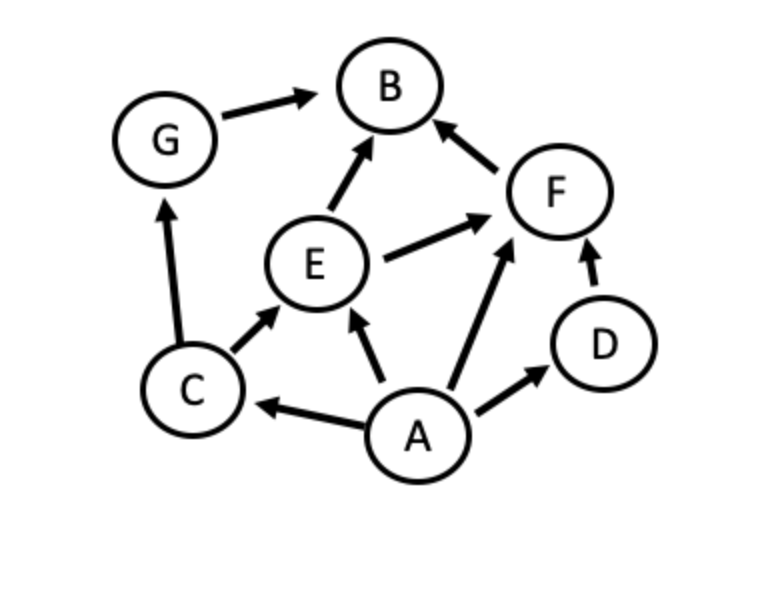
If species B were to experience a decrease in numbers, you would predict a decrease in population sizes of species C.
true
Explanation - F and E are not competitors.
If species B were to experience an increase in numbers, you would predict most trophic interactions to cause an increase in population sizes of species D.
true
Explanation - Two of the three food chains will promote growth of species D.
On average, about how much energy is passed from one trophic level to the next trophic level?
10%
During photosynthesis, energy from light is used to do which of the following?
Transport H+ ions into the thylakoid space to set up a diffusion gradient of protons.
Converting NADP+ to NADPH.
Using the proton gradient to provide energy for ATP synthase to generate ATP.
Energy from the _________ is used to add _________ to ________ and generate _________.
Light-dependent Reactions / CO2 / RuBP / glucose.
RuBisCO is challenging for plants in terms of energy efficiency of photosynthesis because…
it acts as both a carboxylase AND an oxygenase.
In the hot, dry environment of the Wichita Mountains (1.5 hours to the west/southwest of Norman), what type of plants would you expect to dominate the plant community there?
C4
In C4 plants, RuBisCO is protected from binding to Oxygen by...
being kept only in bundle sheath cells.
C4 plants capture CO2 using PEP Carboxylase instead of RuBisCO. This allows C capture to occur in the presence of oxygen because PEP Carboxylase does not bind to oxygen. Because this happens in the mesophyll cells, the bound carbon has to be transported from the mesophyll cells to the bundle sheath cells where it is then recaptured using RuBisCO. Which of the following is a consequence of all this extra processing of CO2 by C4 plants?
In cool, moist environments where plants do not have to worry about water loss due to transpiration, C3 plants are more energy efficient than C4 plants.
Corn is a C4 plant. Which of the following are true of corn?
It will tend to grow well in the Midwest US where it tends to be hot and dry during the summer growing season.
It was grown historically in the desert southwest and northern Mexico which tends to be hot and dry in terms of climate.
Wheat is a C3 plant. Which of the following are true of wheat?
It tends to be grown in the northern US and southern Canada because it is cooler and moister there.
It tends to be grown in western Kansas but requires major irrigation because western Kansas tends to be hot and dry during the growing season.
If intraspecific competition within species 1 is high and species 2 has a large negative effect on species 1’s carrying capacity. Which of the following outcomes of interspecific competition would you expect to occur?
Species 2 always wins.
The relationship between legumes and nitrogen fixing bacteria is an example of which of the following interspecific interactions?
Mutualism
The coloration of a horned lizard is and example of ________ that aids the ________ during the _________ phase of the predation sequence.
crypsis; prey; search
When wolves were reintroduced to the Yellowstone Ecosystem, they affected the movement patterns of elk and deer that then reduced browsing on woody vegetation that increased woody vegetation in the river valleys that then helped recruit beavers to the area resulting in the rivers actually changing course. This is an example of…
top-down effects in a food web.

This photo is showing…
mycorrhizal fungi on the roots of a plant.
The interspecific interaction in the previous question results in which of the following happening? from the photo of the fungi on roots
Plants get more access to phosphorus in the soil.
Plants get more accesses to water in the soil.
Fungi get access to glucose produced by the plant.
You are studying a population of Galapagos tortoises. There are 760 of them living on the island of Española. The per capita growth rate of this population is 0.5. They have a carrying capacity of 2172. They are herbivores and thus have potential competitive interactions with the Galapagos Land Iguana. Luckily for the tortoises, the iguanas feed on a different set of plant material than tortoises, but there is still some competition such that the competition coefficient that quantifies the negative effect of iguanas on tortoises is 0.01. But there are also a lot of iguanas on the island (37,000).
If this population of tortoises is growing under density independent conditions, what would their rate of change be under these conditions? Round DOWN to the nearest whole tortoise.
answer 380
use the density independent equation — dn/dt=rN
You are studying a population of Galapagos tortoises. There are 760 of them living on the island of Española. The per capita growth rate of this population is 0.5. They have a carrying capacity of 2172. They are herbivores and thus have potential competitive interactions with the Galapagos Land Iguana. Luckily for the tortoises, the iguanas feed on a different set of plant material than tortoises, but there is still some competition such that the competition coefficient that quantifies the negative effect of iguanas on tortoises is 0.01. But there are also a lot of iguanas on the island (37,000).
If this population of tortoises is growing under density dependent conditions, what would their rate of change be under these conditions? Round DOWN to the nearest whole tortoise.
247
use density dependent equation — dn/dt= rN(k-N/K)
Given the declines in population growth over the last three questions, does the tortoise population limit itself more than it is limited by land iguanas or do land iguanas limit the growth of tortoises more than tortoises themselves limit their own growth?
Tortoises limit their own growth more than their growth is limited by land iguanas.
Given your answers to the last 4 questions, what do you think the outcome of competition will be in this community of interacting tortoises and land iguanas?
The 2 species will likely coexist.
Which figure below represents the conditions under which Species 1 will always win?
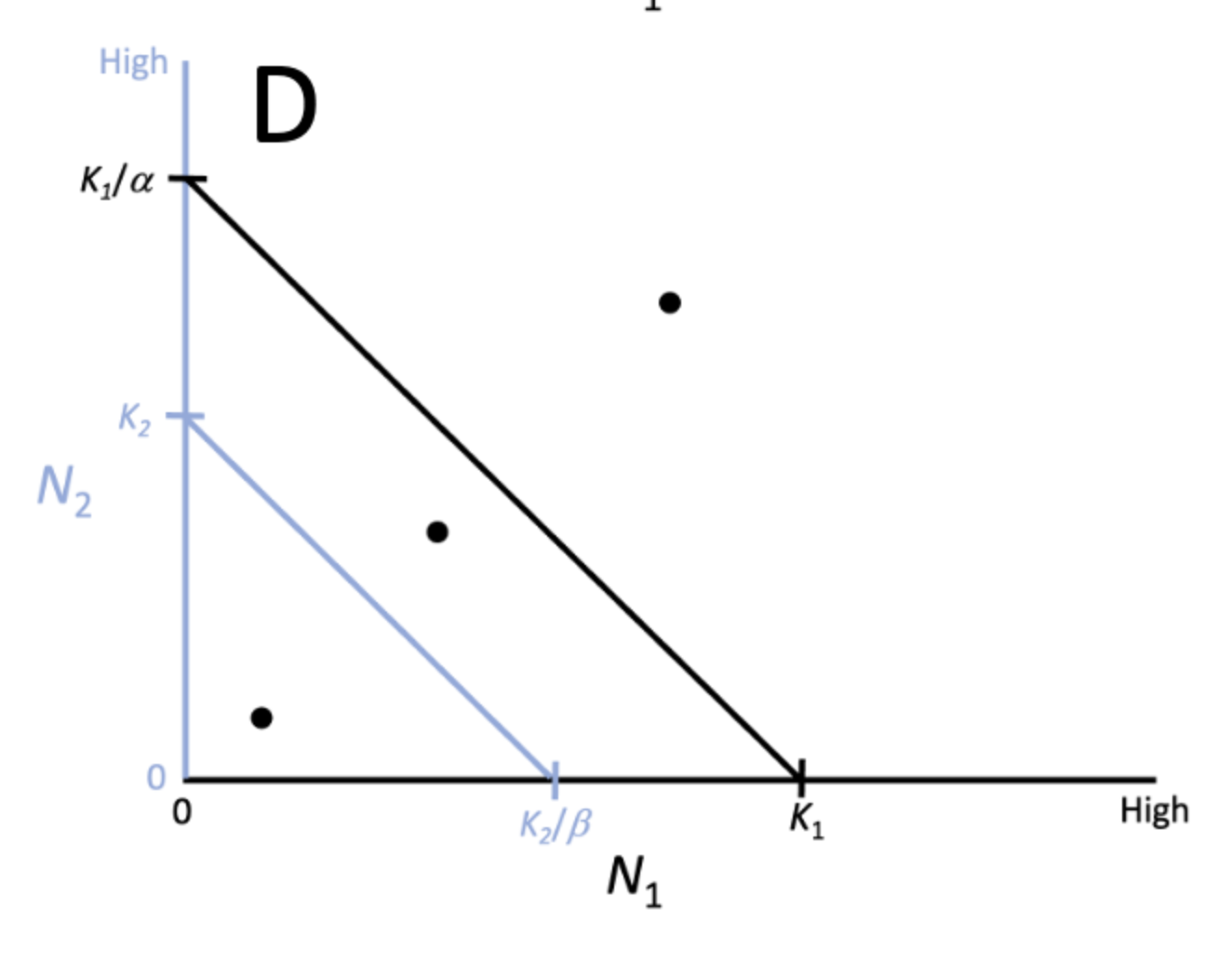
Which figure below represents the conditions under which the two species coexist?

Which figure below represents the conditions under which Species 2 always wins?

Which figure below represents the conditions under which either Species 1 OR Species 2 will win but the outcome of competition is determined by the starting ratios of the two species?
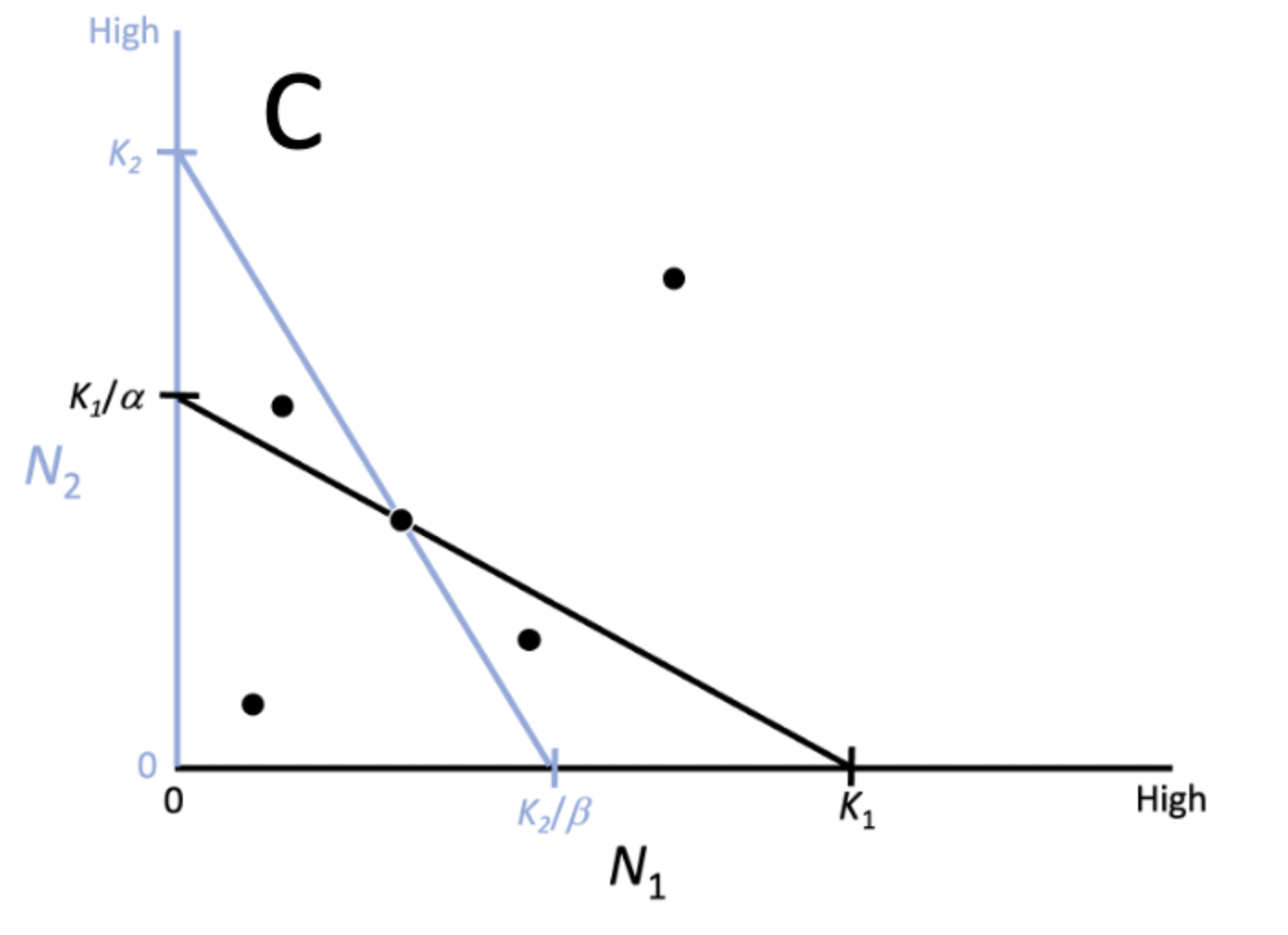
Which of the following is NOT caused by large inputs of solar energy around the equator?
Dry climates on the west side of continents.
Rainforests occur in two regions on earth. They are…
western coastal areas at around 60 degrees north latitude and around the equator.
Here in Oklahoma, we are in the middle of a large temperate grassland biome. This biome occurs here because of which of the following?
We are halfway between a warm moist oceanic current in the east and a cool dry oceanic current in the west.
We lie just north of the dry, descending air that occurs at about 30 degrees north latitutde.
Warm, rising air at 60 degrees north latitude results in amounts of rainfall that support which of the following type of biomes around the world at this latitude?
Boreal forests
Seasonality is caused by which of the following?
The earth’s rotation around its axis is canted at 23.5 degrees from the plane of its revolution around the sun.
Our current carbon cycle includes of the amount of carbon coming out of the atmosphere and into ecosystems (due to photosynthesis) versus the export of carbon out of ecosystems and back to the atmosphere. Which of the following statements is true of this cycle.
The carbon cycle is imbalanced such that more carbon is exported back to the atmosphere than is removed through photosynthesis.
It is impossible to determine how much of global climate change is due to human activities.
false
Climate models are noisy because...
climate is a complex system affected by lots of different kinds of forcing factors.
Warm, moist rising air adjacent to a cold ocean current on the west coast of North America led to which of the following?
The temperate rain forests of the Olympic peninsula.
The famous grunge band Nirvana.
The habit of the University of Washington sending out a campus-wide email proclaiming, "The mountain is out!" whenMount Ranier is visible from campucus because Seattle is legenarily cloudy..
There is a band of deserts around the world at approximately 30 degrees latitude. These deserts tend to be on the west sides of continents. Why?
West sides of continents have cold oceanic currents adjacent to them.
Which of the following is NOT the cause of latitudinal variation in solar energy inputs to the surface of the earth?
The poles are farther away from the sun than the equatorial regions.
Which of the following explains why the southeastern United States is dominated by pine forests even though it straddles 30 degrees latitude?
The presence of the warm Gulf Stream oceanic current right off the coast.
PEP carboxylase is an advantage to C4 plants in terms of energy efficiency of photosynthesis because…
it only acts as a carboxylase.
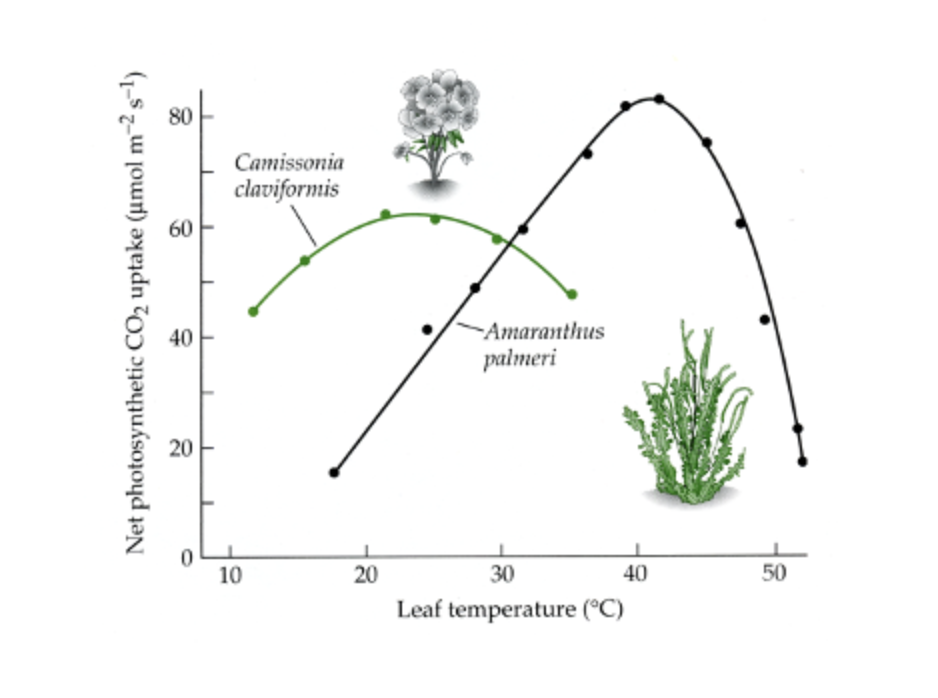
In the figure below, which of the species is the C4 plant based on its photosynthetic efficiency as it varies with temperature?
Amaranthus palmeri
Which of the following interspecific interactions results in positive effects on population growth for one species and negative effects on population growth for the other species?
Predation
You are studying a population of Galapagos tortoises. There are 700 of them living on the island of Española. The per capita growth rate of this population is 0.5. Tortoises have a carrying capacity of 2000. Tortoises are herbivores and thus have potential competitive interactions with the Galapagos Land Iguana. Tortoises and Iguanas feed on similar plant species such that competition between them is relatively strong and α and β are both 0.9. The current population size of the Iguanas is 1000 and the carrying capacity of Iguanas is 8000.
If this population of tortoises is growing under DENSITY INDEPENDENT conditions, what would their rate of change be under these conditions? Round DOWN to the nearest whole tortoise.
350 use density independent equation dn/dt=rN
0.5×700=350
You are studying a population of Galapagos tortoises. There are 700 of them living on the island of Española. The per capita growth rate of this population is 0.5. Tortoises have a carrying capacity of 2000. Tortoises are herbivores and thus have potential competitive interactions with the Galapagos Land Iguana. Tortoises and Iguanas feed on similar plant species such that competition between them is relatively strong and α and β are both 0.9. The current population size of the Iguanas is 1000 and the carrying capacity of Iguanas is 8000.
If this population of tortoises is growing under DENSITY DEPENDENT conditions, what would their rate of change be under these conditions? Round DOWN to the nearest whole tortoise.
227 use density dependent equation dn/dt= rN(K-N/K)
0.5×700(2000-700/2000)
You are studying a population of Galapagos tortoises. There are 700 of them living on the island of Española. The per capita growth rate of this population is 0.5. Tortoises have a carrying capacity of 2000. Tortoises are herbivores and thus have potential competitive interactions with the Galapagos Land Iguana. Tortoises and Iguanas feed on similar plant species such that competition between them is relatively strong and α and β are both 0.9. The current population size of the Iguanas is 1000 and the carrying capacity of Iguanas is 8000.
If this population of tortoises is growing under CONDITIONS OF COMPETITION WITH LAND IGUANAS, what would their rate of change be under these conditions? Round DOWN to the nearest whole tortoise.
70 use conditions of competition equation dn/dt=r1N1(k1-N1-aN2/k1)
0.5×700(2000-700-0.9×1000/2000)
Given the trend in population growth over the last three questions, does the tortoise population limit itself more than it is limited by land iguanas or do land iguanas limit the growth of tortoises more than tortoises themselves limit their own growth?
Land iguanas limit the growth of tortoises more than tortoises limit their own growth,
Given your answers to the last 4 questions, what do you think the outcome of competition will be in this community of interacting tortoises and land iguanas?
Tortoises will be driven to extinction by competition from land iguanas.
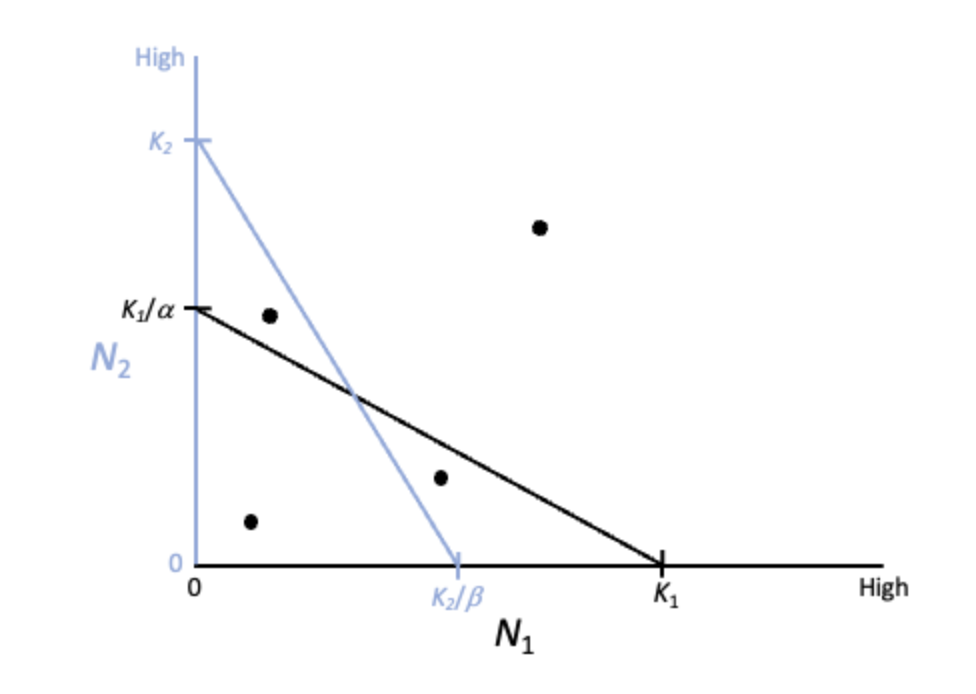
Based on the figure below, what would the outcome of competition be given the various values for carrying capacity and competition coefficients?
Either species 1 or species 2 will win but the outcome depends on the relative abundance of the two species at the beginning of the competitive interaction.
The dorsal coloration of horned lizards is an example of ________ that aids the ________ during the ________ phase of the predation sequence.
crypsis; prey; search
Which of the following represent prey counteradaptations to predator learning?
masquerading
mimicry
aposematism
Which of the following factors contribute to latitudinal variation in solar energy?
The 23.5 degree tilt of the earth's rotational axis (relative to the plane of revolution around the sun).
The fact that the photon density is lower at higher latitudes because the earth is a sphere.
Sunlight experiences more scattering and absorption at higher latitudes because it passes through a thicker slice of the atmosphere at higher latitudes than lower latitudes.
Where would you expect to find deserts?
Around the world at 30 degrees north and south.
At 30 degrees latitude North, you should expect to find deserts but you find deserts in the Western part of the United States and pine forests in the eastern part of the United States. Which of the following account for this difference in biomes that we observe in North America
Warm, ocean currents off the east coast of the United States
Rainforests occur where on the face of the earth?
Around the world at 0 degrees latitude.
At around 60 degrees latitude North
Which of the following fluxes is largest in terms of grams of Carbon per year?
Photosynthesis
In a world without humans, the carbon cycle would normally result in 5 x 1015 g C/year being stored in soils but C is instead exported back to the atmosphere. Which anthropogenic flux is large enough to single-handedly reverse the flow of carbon transforming the carbon cycle into a cycle that results in net export of carbon to the atmosphere?
Combustion of fossil fuels
Which of the following plant tissues is responsible for the movement of water and dissolved substances from the roots to the stems and leaves?
Xylem
In the evolution of plants, what function does the waxy cuticle serve?
Prevention of water loss
in the life cycle of a moss, the gametophyte produces gametes in the archegonium and the antheridium. Which of the following statements represents the next step in the life cycle of a moss?
The sperm fertilizes the ovum forming the zygote that grows into a new sporophyte growing out of the female gameteophyte.
Order the statements such that they reflect how Hadley cells are formed as a result of solar energy inputs—— 1
Solar energy warms the earth and the air masses adjacent to the surface of the earth
Order the statements such that they reflect how Hadley cells are formed as a result of solar energy inputs—— 2
Warm air absorbs water and rises, cooling as it rises higher in altitude.
Order the statements such that they reflect how Hadley cells are formed as a result of solar energy inputs—— 3
Moisture condenses and creates rain.
Order the statements such that they reflect how Hadley cells are formed as a result of solar energy inputs—— 4
Cool, denser air cannot descend because of warm air rising underneath it, so it slides off toward higher latitudes.
Order the statements such that they reflect how Hadley cells are formed as a result of solar energy inputs—— 5
Cool, dry air descends at 30 degrees North and South.
Order the statements such that they reflect how Hadley cells are formed as a result of solar energy inputs—— 6
Cool, descending air warms as it approaches the surface but cannot rise because of cool, descending air on top of the warmer surface air, so it moves back toward the equator.